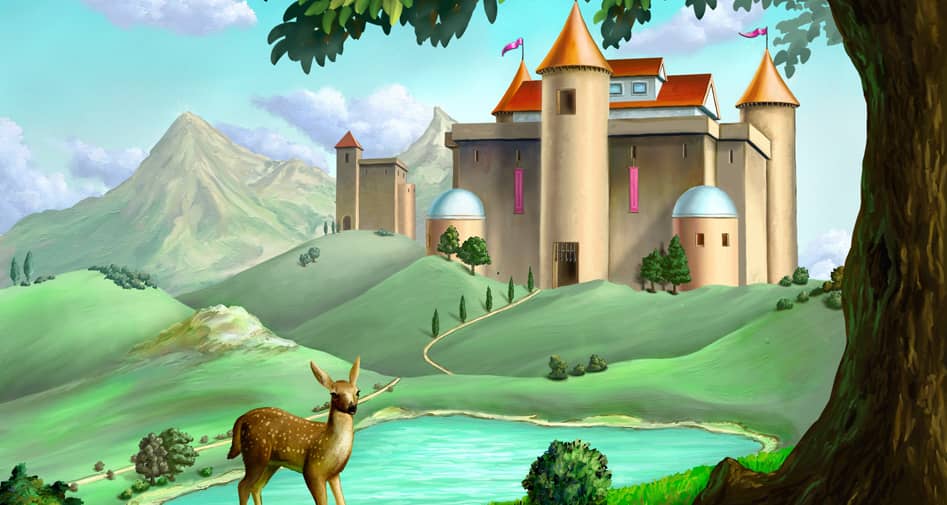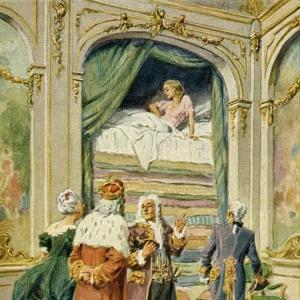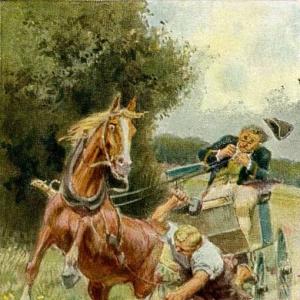Reading time: 9 min
There was once a girl whose father and mother died while she was still a little child. All alone, in a small house at the end of the village, dwelt her godmother, who supported herself by spinning, weaving, and sewing. The old woman took the forlorn child to live with her, kept her to her work, and educated her in all that is good. When the girl was fifteen years old, the old woman became ill, called the child to her bedside, and said, „Dear daughter, I feel my end drawing near. I leave thee the little house, which will protect thee from wind and weather, and my spindle, shuttle, and needle, with which thou canst earn thy bread.“ Then she laid her hands on the girl’s head, blessed her, and said, „Only preserve the love of God in thy heart, and all will go well with thee.“ Thereupon she closed her eyes, and when she was laid in the earth, the maiden followed the coffin, weeping bitterly, and paid her the last mark of respect. And now the maiden lived quite alone in the little house, and was industrious, and span, wove, and sewed, and the blessing of the good old woman was on all that she did. It seemed as if the flax in the room increased of its own accord, and whenever she wove a piece of cloth or carpet, or had made a shirt, she at once found a buyer who paid her amply for it, so that she was in want of nothing, and even had something to share with others. About this time, the son of the King was travelling about the country looking for a bride. He was not to choose a poor one, and did not want to have a rich one. So he said, „She shall be my wife who is the poorest, and at the same time the richest.“ When he came to the village where the maiden dwelt, he inquired, as he did wherever he went, who was the richest and also the poorest girl in the place? They first named the richest. The poorest, they said, was the girl who lived in the small house quite at the end of the village. The rich girl was sitting in all her splendour before the door of her house, and when the prince approached her, she got up, went to meet him, and made him a low curtsey. He looked at her, said nothing, and rode on. When he came to the house of the poor girl, she was not standing at the door, but sitting in her little room. He stopped his horse, and saw through the window, on which the bright sun was shining, the girl sitting at her spinning-wheel, busily spinning. She looked up, and when she saw that the prince was looking in, she blushed all over her face, let her eyes fall, and went on spinning. I do not know whether, just at that moment, the thread was quite even; but she went on spinning until the King’s son had ridden away again. Then she went to the window, opened it, and said, „It is so warm in this room!“ but she still looked after him as long as she could distinguish the white feathers in his hat. Then she sat down to work again in her own room and went on with her spinning, and a saying which the old woman had often repeated when she was sitting at her work, came into her mind, and she sang these words to herself, —
„Spindle, my spindle, haste, haste thee away,
And here to my house bring the wooer, I pray.“
And what do you think happened? The spindle sprang out of her hand in an instant, and out of the door, and when, in her astonishment, she got up and looked after it, she saw that it was dancing out merrily into the open country, and drawing a shining golden thread after it. Before long, it had entirely vanished from her sight. As she had now no spindle, the girl took the weaver’s shuttle in her hand, sat down to her loom, and began to weave. The spindle, however, danced continually onwards, and just as the thread came to an end, reached the prince. „What do I see?“ he cried; „the spindle certainly wants to show me the way!“ turned his horse about, and rode back with the golden thread. The girl was, however, sitting at her work singing,
„Shuttle, my shuttle, weave well this day,
And guide the wooer to me, I pray.“
Immediately the shuttle sprang out of her hand and out by the door. Before the threshold, however, it began to weave a carpet which was more beautiful than the eyes of man had ever yet beheld. Lilies and roses blossomed on both sides of it, and on a golden ground in the centre green branches ascended, under which bounded hares and rabbits, stags and deer stretched their heads in between them, brightly-coloured birds were sitting in the branches above. They lacked nothing but the gift of song. The shuttle leapt hither and thither, and everything seemed to grow of its own accord. As the shuttle had run away, the girl sat down to sew. She held the needle in her hand and sang,
„Needle, my needle, sharp-pointed and fine,
Prepare for a wooer this house of mine.“
Then the needle leapt out of her fingers, and flew everywhere about the room as quick as lightning. It was just as if invisible spirits were working. They covered tables and benches with green cloth in an instant, and the chairs with velvet, and hung the windows with silken curtains. Hardly had the needle put in the last stitch than the maiden saw through the window the white feathers of the prince, whom the spindle had brought thither by the golden thread. He alighted, stepped over the carpet into the house, and when he entered the room, there stood the maiden in her poor garments, but she shone out from within them like a rose surrounded by leaves. „Thou art the poorest and also the richest,“ said he to her. „Come with me, thou shalt be my bride.“ She did not speak, but she gave him her hand. Then he gave her a kiss, led her forth, lifted her on to his horse, and took her to the royal castle, where the wedding was solemnized with great rejoicings. The spindle, shuttle, and needle were preserved in the treasure-chamber, and held in great honour.
 Learn languages. Double-tap on a word.Learn languages in context with Childstories.org and Deepl.com.
Learn languages. Double-tap on a word.Learn languages in context with Childstories.org and Deepl.com.Backgrounds
Interpretations
Adaptions
Summary
Linguistics
„Spindle, Shuttle, and Needle“ is a fairy tale collected by the Brothers Grimm, two German scholars named Jacob and Wilhelm Grimm. The story appears in their famous collection of fairy tales, known as „Grimms‘ Fairy Tales“ or „Children’s and Household Tales“ (in German: „Kinder- und Hausmärchen“), which was first published in 1812.
The Brothers Grimm were part of the Romantic movement in the early 19th century, which was characterized by an interest in folklore, mythology, and the cultural heritage of their country. They aimed to collect and preserve the traditional stories of the German people and spent years traveling through rural areas, gathering tales from different regions.
Many of the tales in their collection, including „Spindle, Shuttle, and Needle,“ have their roots in ancient oral traditions that predate the Grimms‘ work by centuries. These stories were passed down through generations and often changed and evolved over time, reflecting the values and beliefs of the society in which they were told.
While the Brothers Grimm are best known for their collection of fairy tales, they were also influential linguists and philologists. They made significant contributions to the study of the German language, as well as the development of the field of comparative mythology, which examines the similarities and differences between the myths and stories of different cultures.
„Grimms‘ Fairy Tales“ has been translated into more than 100 languages and remains one of the most widely read and beloved collections of fairy tales in the world. The stories have inspired countless adaptations in literature, film, television, and other forms of popular culture, and their themes and messages continue to resonate with audiences today.
„Spindle, Shuttle, and Needle“ offers several interpretations, as with many fairy tales. Here are a few possible interpretations:
The value of hard work and determination: The orphan girl’s persistence in learning and practicing her godmother’s craft of spinning, weaving, and sewing allows her to create quality work. Her dedication to her craft ultimately leads to her meeting the prince, and her fortune.
Humility and inner beauty: The tale highlights the importance of humility and inner beauty over material wealth and superficial appearances. The prince is drawn to the orphan girl because of her modesty and genuine nature, in contrast to the rich girl, who is arrogant and unappealing.
The power of faith: The godmother’s blessing and the girl’s unwavering faith in God play a significant role in the story. The girl’s success and happiness stem from her trust in God and her adherence to her godmother’s teachings.
Magical intervention and destiny: The magical elements in the story, such as the animated spindle, shuttle, and needle, serve as agents of fate, guiding the girl towards her destiny. Their actions lead the prince to the girl and create a beautiful setting for their meeting, emphasizing the idea that destiny and magic can come together to create a happy ending.
The concept of „poorest and richest“: The prince’s quest for a bride who is both the poorest and richest can be seen as a metaphor for seeking someone who possesses true wealth in terms of character, love, and humility, rather than material possessions. The orphan girl embodies this concept, as she is poor in worldly goods but rich in virtues and talents.
„Spindle, Shuttle, and Needle“ is a classic fairy tale that has been adapted and retold in various forms throughout the years. Here are some examples of adaptations of the story.
„The Three Gifts“ (1955) – This animated short film by Disney retells the story of „Spindle, Shuttle, and Needle“ with the addition of music and dance.
„The Princess and the Magic Thimble“ (1989) – This children’s book by Margaret Greaves is a retelling of the story with the addition of a magic thimble.
„Spindle’s End“ (2000) – This novel by Robin McKinley is a reimagining of „Sleeping Beauty,“ with the main character, Katriona, being gifted a spindle, shuttle, and needle and discovering her own magical abilities.
„The Thimble and the Throne“ (2009) – This children’s book by Patricia St. John is a retelling of the story with the addition of a thimble that also has magical powers.
„Once Upon a Time“ (2011-2018) – This television series included several adaptations of „Spindle, Shuttle, and Needle“ throughout its run, with the main character, Emma Swan, being gifted a magical needle that allows her to see into the future.
„The Gifts of the Magician“ (2021) – This short film by Short Circuit on Disney+ retells the story of „Spindle, Shuttle, and Needle“ with a modern twist, as a young girl named Maya receives a magical sewing machine that leads her on an unexpected adventure.
Overall, „Spindle, Shuttle, and Needle“ has proven to be a timeless and adaptable tale, inspiring countless adaptations and retellings across various media.
„Spindle, Shuttle, and Needle“ is a fairy tale by the Brothers Grimm about a young orphan girl who lives with her godmother, a spinster who supports them by spinning, weaving, and sewing. When the godmother dies, she leaves the girl her house and tools, blessing her with success as long as she keeps God in her heart. The girl continues her godmother’s work, and her creations are so excellent that she becomes well-off.
Meanwhile, a prince is seeking a bride who is both the poorest and richest girl in the land. When he comes to the village where the girl lives, he meets the richest girl, who is arrogant and unappealing. He then sees the orphan girl spinning in her house, and is drawn to her humble beauty.
The girl sings songs to her spindle, shuttle, and needle, requesting them to bring her a wooer. They come to life and perform magical feats to fulfill her wish: the spindle weaves a golden thread leading the prince to her, the shuttle creates a magnificent carpet, and the needle decorates the house beautifully.
The prince recognizes the girl as both the poorest and richest and proposes to her. They marry and live happily at the royal castle, where the spindle, shuttle, and needle are honored as treasures. The tale conveys the message that humility, hard work, and faith can lead to great success and happiness.
The fairy tale „Spindle, Shuttle, and Needle“ by the Brothers Grimm can be analyzed linguistically to explore its narrative style, themes, and the language techniques employed. Below is a linguistic analysis based on the elements of a traditional fairy tale:
Simple Language and Syntax: The tale uses straightforward language and uncomplicated sentence structures that are typical of oral storytelling traditions. The simplicity makes it accessible to children, which aligns with the intended audience of fairy tales.
Repetitive Structure: The narrative employs repetition, especially in the actions of the spindle, shuttle, and needle. The repeated pattern of „Spindle, my spindle,“ „Shuttle, my shuttle,“ and „Needle, my needle“ followed by a command creates a rhythmic and musical quality, which enhances memorability and engages the listener.
Direct Speech: Direct speech is used to convey key moments of the story, such as when the godmother gives her parting words or when the maiden sings her requests to the spindle, shuttle, and needle. This technique adds immediacy and intimacy, drawing the reader into the characters‘ world.
Symbolism and Metaphor: Objects such as the spindle, shuttle, and needle are imbued with symbolic meaning. They represent the girl’s industriousness and skill, as well as the magical assistance she receives due to her virtuous nature. The magical elements highlight a common fairy tale theme where goodness leads to supernatural aid.
Contrasts and Paradoxes: The tale explores the contrast between wealth and poverty. The prince seeks a bride who is „the poorest, and at the same time the richest,“ creating a paradox that underscores the moral lesson that true richness comes from one’s character and virtues, not material wealth.
Characterization through Actions: Character traits are revealed through actions rather than detailed descriptions. The maiden’s industriousness and humility are illustrated through her diligent work with the spindle, shuttle, and needle, rather than through direct description.
Moral and Didactic Elements: Like many fairy tales, this story conveys moral lessons. The godmother’s advice to „preserve the love of God in thy heart, and all will go well with thee“ emphasizes the importance of piety and goodness. The narrative suggests that virtue and hard work lead to fortune and happiness.
Use of Imagery: Vivid imagery is employed in describing the carpet woven by the shuttle, with „lilies and roses blossomed on both sides,“ and „haresh, rabbits, brightly-coloured birds,“ creating a rich and fantastical visual scene that appeals to the imagination.
This fairy tale uses these linguistic elements to convey its narrative in a way that is engaging, moralistic, and steeped in the traditional structure of fairy tales, where good triumphs and leads to a prosperous ending.
Information for scientific analysis
Fairy tale statistics | Value |
|---|---|
| Number | KHM 188 |
| Aarne-Thompson-Uther-Index | ATU Typ 585 |
| Translations | DE, EN, ES, FR, PT, HU, IT, JA, NL, PL, RU, TR, VI, ZH |
| Readability Index by Björnsson | 34.2 |
| Flesch-Reading-Ease Index | 79.6 |
| Flesch–Kincaid Grade-Level | 7.3 |
| Gunning Fog Index | 9.5 |
| Coleman–Liau Index | 8.2 |
| SMOG Index | 7.8 |
| Automated Readability Index | 8.2 |
| Character Count | 5.832 |
| Letter Count | 4.497 |
| Sentence Count | 53 |
| Word Count | 1.103 |
| Average Words per Sentence | 20,81 |
| Words with more than 6 letters | 148 |
| Percentage of long words | 13.4% |
| Number of Syllables | 1.384 |
| Average Syllables per Word | 1,25 |
| Words with three Syllables | 33 |
| Percentage Words with three Syllables | 3% |

 Facebook
Facebook  Whatsapp
Whatsapp  Messenger
Messenger  Telegram
Telegram Reddit
Reddit














